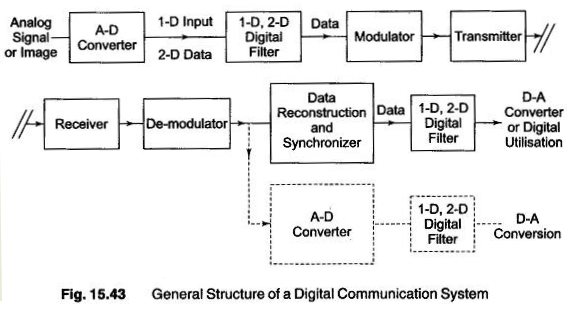Typical Digital Filtering Operations:
Digital filters in fact can be applied in many different parts of a signal and image processing transmission system. Two typical examples of systems in which typical digital filtering operations can be inserted are
- Local digital processing systems (Fig. 15.42), and
- Digital communication system (Fig. 15.43)
In the first system of Fig. 15.42, an analog signal x(t) is converted to digital form by an analog to digital converter, and thereby 1-D x(n) or 2-D x(n1, n2) data are obtained. The 1-D or 2-D digital filter in such systems performs the required operations which may correspond, for example, to some specific frequency requirements. This needs a suitable frequency transfer function H(j ω) or H(j ω1, j ω2) and giving output data that can be immediately locally utilized, i.e. displayed or stored. This output data can be converted back to analog form by a digital to analog converter to produce a signal or an image reconstruction for direct use and presentation, e.g. on an oscilloscope, a plotter, display terminals, etc. It is interesting to observe that the same digital filter, or a suitable section of it, can also be used to give accuracy data interpolation to produce a reconstructed signal, or an image of better quality.
In the second system of Fig. 15.43, an analog signal or image is converted to digital form as in Fig. 15.42, and the data so obtained is processed by a 1-D or 2-D digital filter as required, to specify and delimit the band widths or to perform suitable corrections on the signals.
The filtered data are hence sent through a modulator and a transmitter in the communication channel. The purpose of the modulator-transmitter is to represent the binary data in terms of AM, FM or phase modulation variations of a high frequency signal (carrier), suitable for transmission through the communication channel.
At the receiving terminal a receiver and demodulator reproduce the data which is usually not identical to that transmitted, but altered due to the noise and disturbances introduced in it. For this reason, data are recovered through a data reconstructor-synchronizer. In this way digital filtering can be performed on the received data, so as to extract pertinent information within specific frequency bands and reduce noise and other disturbances.
Alternatively, as shown by dashed lines in Fig. 15.43, one can apply digital filtering directly to the signals given by the demodulator converted to digital form. In this case digital filtering can perform the task of reconstructing data by extracting it from noise.

